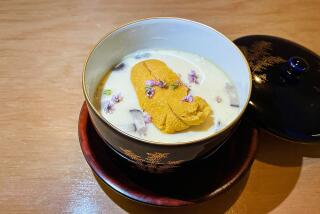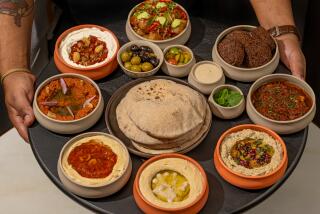Bastide, in a class of its own
THE blue door, shuttered for more than a year and a half, is open once again, and the stage is set for Act 3. Step in, and you’re welcomed with the offer of an aperitif in the enchanting garden where a pair of gnarly olive trees cast lacy shadows on the wall, water falls into a basin, and the air is scented with lavender.
Order Champagne and the sommelier waltzes over with a double magnum of vintage Champagne one night, pours an unusual Sacy rose another time. You might be served breadsticks with transparent gold potato chips and spiced nuts or slender, cheese-laced churros that taste like New World gougeres. The effect is somehow so civilized, you find yourself relaxing into another rhythm.
Bastide is back. This time around, the West Hollywood restaurant feels less formal and a lot more fun. It’s Bastide, unbuttoned. Instead of a focus on strictly French cuisine and wines, the menu, which consists exclusively of two prix fixe tasting menus, presents chef Walter Manzke’s polished contemporary French cuisine spiced with subtle Asian accents. The wine list from sommelier Pieter Verheyde is phenomenally deep but also includes some wonderful bottles at moderate prices.
Service is as good as it gets in Los Angeles: From amuses to chocolates, the experience at Bastide is seamless. It’s also lengthy, and so, just as in Europe, your table -- with its heavy silver, crystal wineglasses and embroidered linens -- is yours for the evening. All this at a price that’s a bargain by European standards.
The result is a restaurant unlike any other, certainly in L.A., and probably anywhere else in the country.
This is restaurant as art form, from an inspired amateur. Owner Joe Pytka’s day job is directing commercials. Famously uncompromising as a director, he’s just as much a perfectionist when it comes to his restaurant. His pockets are deep enough to get whatever he wants, and it’s always the very best -- an accomplished chef, splendid wines, the best ingredients available.
Polished, subtle cooking
MANZKE, the new chef, is a Patina alum who garnered attention with his custom-tailored tasting menus as chef of L’Auberge in Carmel. Here, his cooking is polished and understated. It’s very good. It’s very correct, but, at this point, missing the strong personal stamp that makes magic on the plate.
Sommelier Pieter Verheyde is a Belgian who came up in Alain Ducasse’s temples of cuisines in Monaco and New York. Andree Putman, the revered Paris-based designer who gave Bastide its previous elegant and original look, has freshened up the 5-year-old restaurant with a new checkerboard carpet in one room, tree trunks crowned with sculptures in another room, and a wall of Mao portraits in the hallway. Bastide seats only 32 guests inside (an additional 30 or so can fit in the garden, which includes a 10-person chef’s table, weather permitting) in three diminutive rooms of a small house at the back of the garden.
The menu, which consists of single words such as Tidbits, Ceviche, Thai and Fish, with no descriptions of particular dishes, is written up every day. The price -- $80 for a four-course menu, $100 for the seven-course one, with wine pairings for an additional $60 or $100 per person-- is astonishing for this level of food and wine and service.
Yet Pytka spares no expense. He once paid $35,000 at a charity auction for a 2.2 pound truffle, which he shaved, lavishly, over dishes at Bastide. His cellar holds remarkable wines, including a fabulous collection of older vintages of Burgundy and Bordeaux at equally fabulous prices (but nothing over $90,000 for those on a budget). What other restaurateur could afford to keep the doors closed while he pondered the next move? Or not fill the entire restaurant as he did in the initial weeks?
One night a friend and I sit at a corner table (one of four) in the serenely elegant front dining room with its striking checkerboard carpet and fireplace. A waiter who wouldn’t have looked out of place in an 18th century French palace brings us the chef’s signature amuse, a delicious -- and amusing -- deconstructed taco. On the right of the rectangular dish is a crystal clear salsa shooter that tastes exactly like tomatoes and chiles with a sliver of fried tortilla laid across the top. A spoon holds an exquisite bite of lobster snuggled up to a dab of guacamole, and the last item is a scoop of sweet-tart lime sorbet drenched in premium tequila.
A second lovely amuse is octopus ceviche crowned with a savory gazpacho sorbet; No. 3 is a crudo trio that includes a crisp, briny oyster sitting on a gossamer green apple gelee -- fabulous! -- and diced hamachi in a light, complex soy sauce.
A server offers dinner rolls, each delightful: a miniature French baguette, a tall, tender bacon brioche (or a Gruyere version), potato-fennel bread, and a pale green focaccia flavored with basil.
For anyone who dined here under opening chef Alain Giraud’s tenure or that of his successor, Ludovic Lefebvre, the ghosts of meals past are ever present. I can see Giraud bent over the stove, his silver mane flopping, or Lefebvre experimenting with his arsenal of exotic spices and ingredients.
Bastide’s Act 1 was classic French, and when Pytka got bored, he fixated on the fashionable and the cutting edge for Act 2. This third act is tame contemporary French cooking with global accents, a more relaxed attitude and a wine list that outshines the kitchen in its bold expeditions to far-flung regions and cellars.
Adventures in wine
VERHEYDE is one of the best sommeliers I’ve ever encountered. Comfortable with people, he wears his knowledge lightly and, with that twinkle in his eye, manages to convey a sense of fun and adventure. He likes to play, and turn guests onto wines they wouldn’t normally consider trying, or may not even know exist. He has wines on the ever-expanding list that would stump the most knowledgeable wine geek. And if you let him, he’ll take you on a wild ride through Slovenian or Languedoc cellars, the Mosel or Santa Ynez.
The beautiful thing is that wines on the list are not all priced in the stratosphere. The humblest bottle is just $26, but it’s something you might want to drink. The most expensive costs in the tens of thousands. One of the oldest is an 1847 Chateau d’Yquem that Pytka may or may not be inclined to sell.
With the scallops, Verheyde might say, “I’m going to pour a Sylvaner from a friend of Ernie Loosen,” referring to the owner of the famous Dr. Loosen estate in the Mosel. Flowery and crisp, the Sylvaner is a beautiful match with the sea scallops, fat sweet cushions served with a tricolore salad and drizzled with 25-year-old aceto balsamico.
Once I was seated in the single table in the very back dining room, which looks onto the kitchen under a playful Ingo Maurer chandelier outfitted with clips meant to hold pieces of paper -- poems, scribblings, whatever. Bastide’s bristles with labels from some of the best bottles Pytka has ever drunk. I look up and notice a small baggie filled with dark brown-red liquid hanging from a clip. What is it? The dregs from a bottle of 1978 Petrus. That’s serious.
Soup’s up now as waiters arrive, bearing porcelain bowls with tapioca pearls, barely cooked tiger prawns and peanuts at the bottom. A thick coconut carrot soup is poured over the top, sending up a fragrance of coconuts and exotic spices. The Thai soup is almost there, but too rich, too sweet and in dire need of hot pepper for balance. It’s global, but without an edge.
Sauteed turbot with braised cabbage, black truffles and a silky Meyer lemon leek sauce, though, is a beautifully subtle dish that’s perfect with Ambullneo Vineyards Chardonnay from Santa Maria Valley. Risotto topped with sliced duck breast is a very French, overly rich rendition of the Italian dish. The same goes for the pumpkin ravioli lined up in a row and topped with slivers of squab breast: The garnish not only looks unattractive, it detracts from the main event, which is the ravioli and its luscious pumpkin stuffing.
The meat course is usually a straightforward dose of protein -- excellent, but generally not all that interesting after what came before. Suckling pig, served as a succulent patty with lentils and a soft-cooked egg on top, is deliriously good, though -- outshining the respectable braised short ribs in a swirl of dark jus and the single meaty lamb chop in all its appealing lambiness.
Ah, but the vegetable is a tempura that would give any tempura master pause, it’s so gossamer light. And the wine is a gorgeous Chateauneuf du Pape called “Secrets de Pignan,” from La Bastide Saint Dominique that’s almost impossible to find.
The menu isn’t written in stone. If you’d prefer a main course from the menu you’re not having, no problem. Water is, refreshingly, included. Valet parking is complimentary, too. Service is a straight 18% added to the bill, so there’s nothing to worry about except enjoying the play of food and wine.
Desserts from Margarita Manzke, the chef’s wife, who is also responsible for the breads, might be something like her riff on pumpkin pie, a satiny pudding served with a shot of hot chocolate. Nice, but too much of a cliche these days. Wait for her exquisite molded chocolates in flavors such as kumquat, raspberry or Earl Grey tea. Just as you reach for a chocolate, Verheyde may propose a glass of 1981 Armagnac, sublime with the dark chocolate.
Before we know it, the clock reads close to midnight and the evening meanders to a close. This time around, the restaurant isn’t all about the chef. Manzke, as good as he is, is just one part of the gestalt.
I don’t find myself dreaming about any one dish, maybe because the food is woven so inextricably into the fabric of the experience. The new Bastide is an ensemble piece.
Pytka has plans to open for lunch soon, and possibly breakfast. Whether this happens or not (the guy has been known to change his mind), I can’t wait to see how things play out this time around.
Bastide
Rating: ***
Location: 8475 Melrose Place, West Hollywood; (323) 651-5950.
Ambience: Elegant and intimate restaurant in a house at the back of a garden. The menu is fixed-price only with no choices, either four or seven courses, and showcases Patina alum Walter Manzke’s cooking, which is French with global influences. Sommelier Pieter Verheyde makes inspired wine matches from the phenomenal cellar.
Service: Crisp and professional.
Price: Four-course prix fixe menu, $80 per person, $140 with wine pairing; seven-course prix fixe menu, $100 per person; $200 with wine pairing.
Best dishes: The menu changes daily and may include such dishes as deconstructed taco amuse, trio of crudo, turbot with Meyer lemon leek sauce, suckling pig with lentils and soft-cooked egg, handmade chocolates.
Wine list: A stellar list that includes many fabled older bottles but also many interesting bottles under $50, and from all over the world. No outside wines permitted.
Best table: The chef’s table with a view into the kitchen.
Details: Open for dinner from 7 p.m.; last seating at 9 p.m. Tuesday through Saturday. Wine and beer. Complimentary valet parking.
Rating is based on food, service and ambience; price taken into account in relation to quality. ****: Outstanding on every level. ***: Excellent. **: Very good. *: Good. No star: Poor to satisfactory.
More to Read
Eat your way across L.A.
Get our weekly Tasting Notes newsletter for reviews, news and more.
You may occasionally receive promotional content from the Los Angeles Times.






